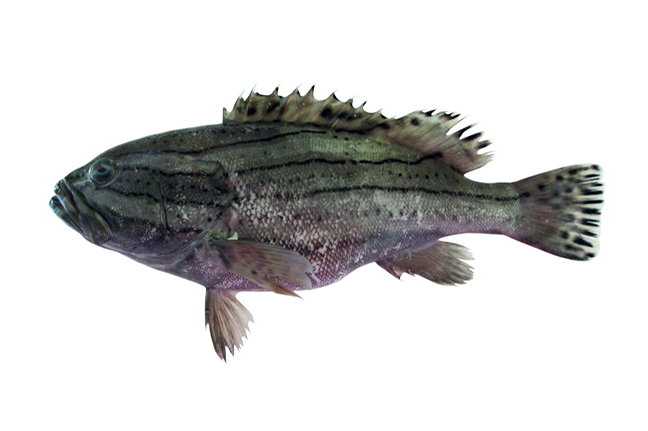- Classification
- ACTINOPTERYGII
- PERCIFORMES
- SERRANIDAE
- Epinephelus
- latifasciatus
Striped Grouper, Epinephelus latifasciatus (Temminck & Schlegel 1843)
Other Names: Banded Grouper, Laterally-banded Grouper, Spotfin Rockcod, Spotty-finned Rock-cod

Juvenile Striped Grouper, Epinephelus latifasciatus. Source: Australian National Fish Collection, CSIRO. License: CC By Attribution-NonCommercial-ShareAlike
Summary:
Large adults are uniformly grey or have several rows of very small spots along the side. Juveniles are lavender-grey to pale brownish, becoming whitish below, with two black-edged white stripes along the side, the upper running from above the eye to the soft dorsal fin, and the lower band from the mouth below the eye to the lower part of the tail.
Cite this page as:
Bray, D.J. 2020, Epinephelus latifasciatus in Fishes of Australia, accessed 25 Apr 2024, https://fishesofaustralia.net.au/home/species/4673
Striped Grouper, Epinephelus latifasciatus (Temminck & Schlegel 1843)
More Info
|
Distribution |
North-western Western Australia, to the Arafura Sea, Northern Territory. Elsewhere, the species is widespread in the tropical, Indo-west Pacific. Large fish inhabit coarse sand or rocky areas, while juveniles prefer silty-sand and muddy bottoms. |
|
Features |
Dorsal fin XI, 12-14; Anal fin III, 8. Body depth 2.9-3.4 times in SL; head length 2.3-2.6 times in SL; interorbital area convex, dorsal head profile convex; preopercle angular, 3-7 distinctly enlarged serrae at angle; upper edge of operculum distinctly convex; anterior and posterior nostrils subequal; maxilla reaching beyond vertical at rear edge of eye; midlateral part lower jaw with 2-3 rows of teeth. |
|
Size |
Dorsal spines (total): 11; Dorsal soft rays (total): 12-14; Anal spines: 3; Anal soft rays: 8. Distinguished by the following characteristics:; body depth contained 2.9-3.4 times in SL; head length 2.3-2.6 times in SL; convex interorbital area, convex dorsal head profile; angular preopercle, 3-7 distinctly enlarged serrae at angle; distinctly convex upper edge of operculum; subequal anterior and posterior nostrils; maxilla reaches past vertical at rear edge of eye; 2-3 rows of teeth on midlateral part of lower jaw |
|
Colour |
Juveniles: lavender-grey or pale brownish, shading to white ventrally; 2 black-edged white longitudinal bands, upper band extending from above eye to anterior dorsal-fin rays, lower band from below eye to lower caudal-fin rays; black spots and streaks on dorsal and caudal fins. Large adults: head and body uniformly grey. |
|
Fisheries |
Fished commercially in parts of its range. |
|
Species Citation |
Serranus latifasciatus Temminck & Schlegel 1843. Fauna Japonica 4: 6. Type locality: Japan. |
|
Author |
Bray, D.J. 2020 |
|
Resources |
Striped Grouper, Epinephelus latifasciatus (Temminck & Schlegel 1843)
References
Allen, G.R. 1997. Marine Fishes of Tropical Australia and South-east Asia. Perth : Western Australian Museum 292 pp. 106 pls.
Bleeker, P. 1879. Énumération des espèces de poissons actuellement connues du Japon et description de trois espèces inédites. Verhandelingen der Koninklijke Akademie van Wetenschappen 18: 1-33 pls 1-3
Craig, M.T., Sadovy de Mitcheson, Y.J. & Heemstra, P.C. 2011. Groupers of the World: a Field and Market Guide. Grahamstown, South Africa : NISC Ltd 356 pp., Appendix 47 pp.
Gloerfelt-Tarp, T. & Kailola, P.J. 1984. Trawled Fishes of Southern Indonesia and Northwest Australia. Jakarta : Dir. Gen. Fish. (Indonesia), German Tech. Coop., Aust. Dev. Ass. Bur. 406 pp.
Heemstra, P.C. & Randall, J.E. 1993. Groupers of the World (Family Serranidae, Subfamily Epinephelinae). An annotated and illustrated catalogue of grouper, rockcod, hind, coral grouper and lyretail species known to date. FAO Fisheries Synopsis No. 125 Vol. 16. Rome: FAO. pp. 1-382
Heemstra, P.C. & Randall, J.E. 1999. Family Serranidae. pp. 2442-2548 in Carpenter, K.E. & Niem, T.H. (eds). The Living Marine Resources of the Western Central Pacific. FAO Species Identification Guide for Fisheries Purposes. Rome : FAO Vol. 4 pp. 2069-2790.
Larson, H.K., Williams, R.S. & Hammer, M.P. 2013. An annotated checklist of the fishes of the Northern Territory, Australia. Zootaxa 3696(1): 1-293
Law, C. 2018. Epinephelus latifasciatus . The IUCN Red List of Threatened Species 2018: e.T132735A46627759. https://dx.doi.org/10.2305/IUCN.UK.2018-2.RLTS.T132735A46627759.en. Downloaded on 04 March 2020.
Ma, K.Y. & Craig, M.T. 2018. An inconvenient monophyly: an update on the taxonomy of the groupers (Epinephelidae). Copeia 106 3): 443-456.
Ramm, D.C. 1997. Assessment of groundfish stocks in northern Australian waters between 127–137°E. Final report to the Fisheries Research and Development Corporation on project 90/15, and the Fisheries Management Authority. Northern Territory Department of Primary Production, Fishery Report 38: 1–85
Randall, J.E. & Heemstra, P.C. 1991. Revision of Indo-Pacific groupers (Perciformes: Serranidae: Epinephelinae), with descriptions of five new species. Indo-Pacific Fishes 20: 1-332.
Russell, B. & Heemstra, P.C. 2008.Epinephelus latifasciatus. The IUCN Red List of Threatened Species 2008: e.T132735A3436346. http://dx.doi.org/10.2305/IUCN.UK.2008.RLTS.T132735A3436346.en. Downloaded on 10 June 2016.
Sainsbury, K.J., Kailola, P.J. & Leyland, G.G. 1985. Continental Shelf Fishes of Northern and North-Western Australia. Canberra : Fisheries Information Service 375 pp. figs & pls.
Temminck, C.J. & Schlegel, H. 1843. Pisces. 1-20 pls 1-7 in Siebold, P. Fr de (ed.) Fauna Japonica. Leyden : Apud Arnz & Socios Vol. 4.




